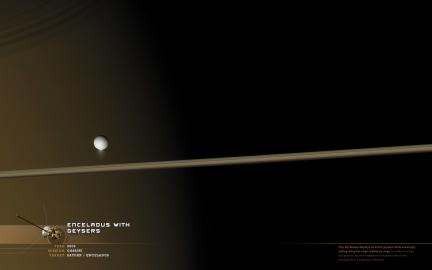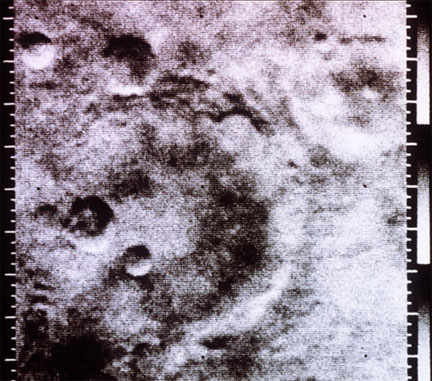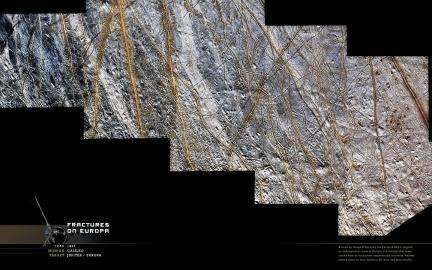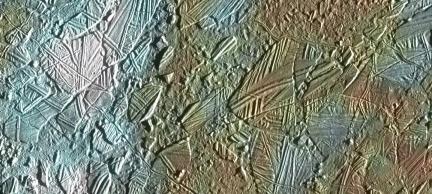 How did I miss this? Europa Report is based upon a future manned mission to Jupiter’s moon Europa. It was developed with mission specialists from NASA — so the details and events depicted are presented in more sciFiFact than in the traditional Hollywood SciFi. Sounds pretty incredible for lovers of real space exploration.
How did I miss this? Europa Report is based upon a future manned mission to Jupiter’s moon Europa. It was developed with mission specialists from NASA — so the details and events depicted are presented in more sciFiFact than in the traditional Hollywood SciFi. Sounds pretty incredible for lovers of real space exploration.
Intelligent Life in 20
 The image above shows what New Horizons looks like to the new Allen Telescope Array which has just come online this fall. The array is currently a collection of 42 antennas which will grow to around 350 over time and it will begin to scan the sky for signs of intelligent life like the one shown above. According to Seth Shostak of SETI, if you draw out some well respected formulas to their logical conclusions… you should be looking at mankind discovering evidence of intelligent life somewhere inside of 20 years from now.
The image above shows what New Horizons looks like to the new Allen Telescope Array which has just come online this fall. The array is currently a collection of 42 antennas which will grow to around 350 over time and it will begin to scan the sky for signs of intelligent life like the one shown above. According to Seth Shostak of SETI, if you draw out some well respected formulas to their logical conclusions… you should be looking at mankind discovering evidence of intelligent life somewhere inside of 20 years from now.
See the full article at Universe Today.
Phoenix’s Probable Last Surface Image
 On the Phoenix Mission’s 152nd Sol (a Martian day) the lander has fallen silent and mission engineers have been unable to communicate with it for over a week. This was expected as the Martian sunlight is less and less as the season changes. The sun is simply not providing enough energy to replenish its solar batteries. There is an outside chance that communications might resume again, but it would be a fleeting opportunity at best.
On the Phoenix Mission’s 152nd Sol (a Martian day) the lander has fallen silent and mission engineers have been unable to communicate with it for over a week. This was expected as the Martian sunlight is less and less as the season changes. The sun is simply not providing enough energy to replenish its solar batteries. There is an outside chance that communications might resume again, but it would be a fleeting opportunity at best.
In all, the mission prooved the existence of water-ice in the Martian subsurface; we saw (with our own eyes) Martian ice melting; it was the first time an atomic force microscope was used outside the bonds of Earth; the discovery that Martian soil may not be that different from the Earth’s and that growing plants in it may not be at all difficult; Phoenix found trace amounts of salt which could be nutrients for life; and finally calcium carbonate which suggests a past existence of liquid water on the surface of an anchient Mars.
And who could forget this image. Not too shabby.
Argh
“Evidence of Soil Habitability Inconclusive.”
See The Planetary Blog on the results from Phoenix. Results could actually be the opposite of what we are hoping for…
Life Online
“Many people -- including, I must admit, me -- took this sentence to mean that a special briefing had taken place, alerting the White House to some positive news about life on Mars.”
Emily Lakdawalla comments on the Phoenix hub-bub which may have been over-blown.
Life On Mars
“It would appear that the US President has been briefed by Phoenix scientists about the discovery of something more "provocative" than the discovery of water existing on the Martian surface.”
Emily Lakdawalla of the Planetary Society will host a web stream on this matter Wednesday night.
Martian Soil Could Support Life
 It looks like Phoenix is finding results with chemistry analysis tests that suggest Martian soil could - or could have supported life. We have known for a while now that elements like magnesium, sodium, potassium and chlorine are all found in Martian soil. Now we also know that the soil alkalinity is comparable to that which we grow all kinds of plants in here on Earth.
It looks like Phoenix is finding results with chemistry analysis tests that suggest Martian soil could - or could have supported life. We have known for a while now that elements like magnesium, sodium, potassium and chlorine are all found in Martian soil. Now we also know that the soil alkalinity is comparable to that which we grow all kinds of plants in here on Earth.
There are more tests to be done, but these results could make growing vegetables in Martian soil a reality one day. It also makes it more conceivable that some kind of life may one day have existed on Mars… or even currently.
The Phoenix Ice Melt
 Thank you… its just what we came for. Now, can we have that in a glass or perhaps with some bacteria?
Thank you… its just what we came for. Now, can we have that in a glass or perhaps with some bacteria?
Life in the Hood: Elsewhere
When mankind set out to observe every major known body in the Solar System, we expected to find that the planets were easily the most interesting places to study. The assumption would have been that most, if not all the moons, were just like our own – cratered. Perhaps they were made of some different materials like ice, but for the most part we expected craters. Apart from that, all we knew was that Titan would be an interesting place because it had a substantial atmosphere. However, once the grand tour of the Voyager crafts were over, we wound up looking far longer and more dumbfounded at the images of a shockingly alien and volcanic Io, or the intricately cracked shell surface of Europa. Titan, it turned out, only frustrated us as Voyager was unable to make out a single damn feature on the surface due to its thick and hazy atmosphere. Few things turned out to be as expected.
As I suggest in my life-on-Titan fantasy, we really don't know what and where we may find just about anything. A few years ago we talked about water on Mars in terms of millions of years ago. Then we talked about the water on Mars scenario as being played out perhaps a few hundred-thousand years ago. Now we find out that at least part of the water on Mars story is as young as last week. Point being that we often find nothing where we expect to find something and find everything where we expected to find nothing. So maybe by these standards the only other life in our Solar System is a few thousand miles down deep in the clouds of Jupiter? Maybe we will one day find microbes in hibernation on a wayward asteroid that was blown off the surface of some fantastic planet and traveled the millennia across time and space from a wholly different star system?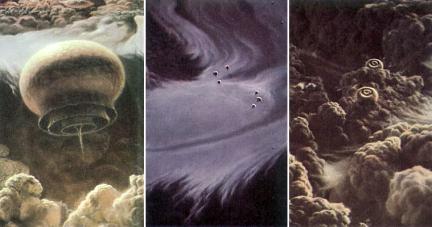
I always recall the images presented in “Cosmos” of what Carl Sagan imagined beings from Jupiter might be like. He imagined they would be quite large and have a structure that would thrive in the intense pressure of the Jovian atmosphere. Looking more like some sort of massive sea creatures, they would float across a limited zone of the Jovian atmosphere and have no need of a terrestrial surface. Sagan even imagined that there might be other Jovian life-forms which could be natural predators of the floaters. These creatures looked like flying fish and seemed even more fantastic than the ones that were imagined previously. But what was exciting was that a serious mind like Carl Sagan didn't consider such possibilities complete folly… surely he was aware their likelihood was slight, but he wasn't beyond imagining the possibilities. For me a child of 8 years, that inspired me. A serious and important man like Sagan thought there could be life, not just microbes on Mars, but creatures on a place as exotic as Jupiter.
Awesome.
Life in the Hood: Titan
Once we leave the realm of Mars, Europa and Enceladus we have to entertain more fantastic possibilities for life elsewhere which are harder to imagine. Titan, it is assumed, would be far too cold all over (no warm spots here) for any form of life to ever take hold. However, this is assuming that all life-forms are carbon based and depend on water to survive.
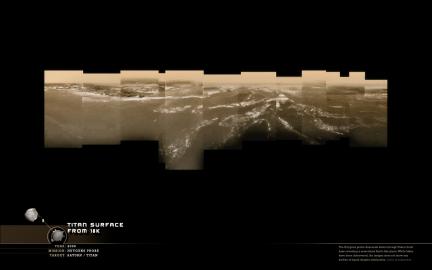
On Titan we have what some call a much colder early Earth where methane plays the role that water does here on Earth. On Titan it rains methane and liquid methane collects on its surface to create rivers and even lakes. So what makes Titan an interesting subject in the conversation of where to look for life is only in that it seems so Earth-like. Compared to all the other bodies it is the only one that has almost everything Earth does – rivers, lakes, shores, volcanos, clouds, rain, lightning – an entire process that mimics the role water plays here on Earth only with methane instead, it even contains carbon compounds (the first essential to life). What if… in the remotest of possibilities… some form of life came to be here that instead thrives off of these elements? Perhaps all that life needs to thrive is a living planet which hosts materials that evaporate and make clouds which in turn rain those materials back down to the surface in liquid form to reshape and carve out the surface keeping it fresh. Who is to say that all life-forms in the universe need water and oxygen to exist? Why not sulfur? Why not Methane?
But life as we know it here at home is hardly likely on Titan. So far there is no evidence of water, temperatures or even oxygen to support a more earthly organism for even a scant of a second. Finding life in a place like Titan would be far more revolutionary than finding it on Mars, Europa or Enceladus because it would have to be so totally different from all living things that we have ever seen. It would change the very foundations of what we thought we knew about biology… Don’t get me wrong, life anywhere apart from Earth would be mind-blowing and the possibility of comparing a life-form which evolved wholly apart from all living things on Earth would be a staggeringly exciting concept to just about anybody. But discovering a life-form so totally independent from all the rules of Earth based biology would not only be fascinating, but it would also more or less verify that the universe is indeed lousy with all kinds of life-forms and would also many-fold increase the likelihood that somewhere out there are intelligent beings with which we may one day be able to communicate with. A situation that would suddenly turn science-fiction to fiction.
WALLPAPER NOTE: Color is subjective.
Life in the Hood: Enceladus
When the Voyagers sped through the outer Solar System in the 1980’s they returned the first images of the smaller moons of the Solar System, those of Saturn and Uranus. These bodies are large enough to maintain a spherical shape – but are considerably smaller than the junior planet sized class of moons which would include Titan, our own moon and a five others. At these smaller sizes (ranging from around 400 km to 800 km in diameter) the gravity is expected to be too weak to hold down any kind of atmosphere and the mass too small to generate any kind of internal heating. These are two factors that usually result in any kind of intriguing features like weather, volcanos, tectonics, geysers or more simply – anything that is not just another crater or the result of some kind of an impact. Nobody was expecting to find anything of interest which could be dated as any newer than from the time around which the Solar System was formed. Even our own moon, at its much larger scale, is for the most part “dead” and has been unchanged since it cooled off millions of years ago.
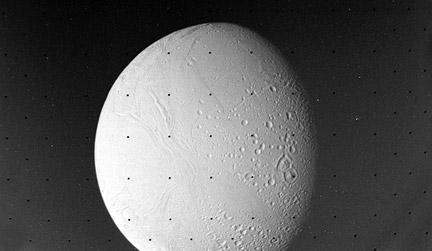
Well, whenever making assumptions about what one might expect to find upon exploring the Solar System, we are always prepared to be delightfully wrong. One the smaller moons of Saturn, named Enceladus, did turn some heads when the Voyagers sped by in the early 80’s (see above), but it wasn’t until Cassini arrived that it turned out to be an unexpected jewel in Saturn’s crown. From some vantage points, looking at Enceladus you might note the “muddy” looking impact craters on the surface and the unusually smooth surface in some regions, but apart form that – you would think that Enceladus was much like the other smaller moons of Saturn and Uranus – cold, cratered and frozen to the core. There didn’t seem to be anything going on around this tiny world any newer than perhaps a few tens of millions of years.

In 2005, the Cassini spacecraft got a better look at Enceladus and in particular noted a large area somewhat devoid of impact craters with unusually smooth ridges or “tiger stripes” (see above image of Enceladus from 172km) in a large southern region of the small moon. A lack of impact craters usually tells us that what we’re looking at is geologically active and depending on how few there are, tells you how young the surface is. The lack of almost any kinds of craters in this southern region led some to wonder if there may be some kind of unexpected activity going on, namely geysers (see below).

so in 2006, Cassini took an over-exposed look at a thin crescent Enceladus and there it was… a number of active geysers spewing out water ice miles into the space around Enceladus. Suddenly this tiny cold dead world leapt to life and is even rivaling Europa at Jupiter in terms of generating excitement for possibilities of finding life. Here on Earth we have come to expect life to rise anytime you have water in some fashion available. Life forms it seems, especially ones called extremophiles, seem to figure out a way to survive without sunlight, oxygen and nearly every other element larger animals like us need to survive. The only one thing that seems to always need to be present though is water. So whenever scientists find water in some form on another world, speculation starts to rise in the possibilities that life may have taken a foothold there and could possibly have survived and evolved to the present day.
Theories are still being drawn up to explain the activity on a world that should be frozen solid to the core and as “dead” as an asteroid. A likely guess is that something akin to what is happening on Europa is also happening at Enceladus. Its proximity to Saturn and the fact that it is largely made of something more easily melted such as water ice instead of rock (as Mimas is, which is actually in even closer to Saturn). What is curious is why the activity is isolated to the southern region? Up north the moon looks almost as battered as any other which establishes that these regions are fairly old.
For some years now a Europa Orbiter mission has be on the drawing boards at NASA, but many have begun to challenge the idea that the next Cassini/Galileo class mission to the outer Solar System should be to Enceladus instead of Europa. While Europa is active in some form, it is unclear what one may find at the surface. The meat of what we’re looking for may be miles below the icy crust and nobody is sure what kind (if any) of access there may be even at places where the ridges seem fresh and recently broken. Whereas, on Enceladus, there are active geysers currently releasing materials into space which makes capturing some of the materials much easier if not actually having access through some form of cryo-caldera. One attractive idea is to have some form of mission to Saturn/Enceladus that works similarly to the way Stardust worked. Simply fly in close to the active region, open up the collector and return it to earth. This worked fantastically at the comet Wild 2 and there is no reason to believe that it couldn’t work just as well at Enceladus.
NOTE: At the time of this writing, some questions have been raised about the nature of the geysers on Enceladus. A new model proposes that these fountains may not be composed of water ice.
WALLPAPER NOTE: the wallpaper image above is a composite image where the overall scene is actual, but the details of Enceladus’s geysers are from actual images of the geysers laid over the top of the background image. In actuality, the details of the geysers are only visible with over-exposed images which would make the relatively well exposed background scene impossible to image in the same exposure.
Life in the Hood: Mars
While most scientists are more excited by some of the possibilities that Europa may offer, the next most likely place to find some kind of life is still Mars. Even after all the landers, rovers and orbiting observers, Mars still keeps dropping hints that there may still be some kind of rare environs in a few places where any life that may have once flourished could still have survived these many millions of years since the planet dried up. Just last week the first direct evidence of liquid water moving across its surface was presented at a special news conference based upon the observations of the now defunct Mars Global Surveyor (see wallpaper image below). Perhaps whatever small amount of underground water still exists on Mars still plays host to some simple forms of life which have adapted and learned to also go to where the water went, which seems to be underground.

Most expect that if we ever find anything hopeful on Mars it will be in the form of a fossilized record. Many doubt that life on Mars is current and the assumption is that the odds are highly in favor of Mars having once been a habitable place many, many years ago when it was much wetter. There is a huge amount of evidence on that presents us with what looks like a once saturated landscape of rivers, lakes and even oceans. Had this been the case, it seems very likely that Mars may have once given rise to life on its surface and if it did – there would likely be a vast geological record of these organisms left behind.
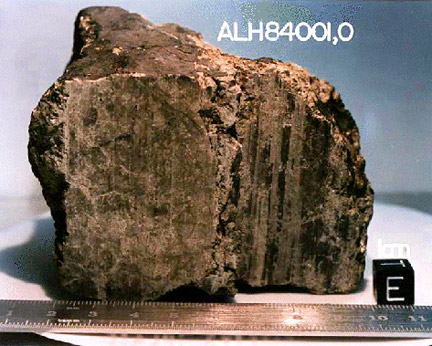
In a related story… once in a while an Antarctic meteorite remnant is found that turns out to be one of a very rare kind which scientists are now sure are of Martian origin (they have 12 of these actually). They know this because when they drill into these meteors and find small bubbles of gas exist (as they do in most rocks) that contain almost the same exact composition of gasses that are found in the atmosphere on Mars. Leaving us with the conclusion that they must be of Martian origin as the coincidental likelihood of a rock left over from the formation of the Solar System having trapped gasses which exactly match that of the Martian atmosphere is extremely thin – if not impossible. The theory goes that some colossal impacts took place on Mars which scattered debris largely on the surface, but left a few chunks flying so fast and furious at the right speeds that they not only escaped the Martian atmosphere, but even the gravitational pull of Mars itself. Whereas they are left to wander the solar system for potentially millions of years until a chance encounter with the Earth results in an all-natural cosmic sample return mission from Mars.
 In the 90’s a paper was published in Science magazine that proposed the discovery of the first organic compounds to be found in a Martian meteorite. Furthermore, the authors of this paper observed that there may be mineralogical features that may be fossil evidence of ancient Martian organisms (see left). Excitement on this finding was high and the impact of its meaning went as high as the President of The United States making a specific statement on it at a news briefing, after all, it would be the first evidence of life outside of Earth to have ever been detected. Since that exciting time, many scientists have come out to refute each of the individual findings and have stated that they each could have each come from processes which were non-biological. However, the paper’s authors still contend that circumstances are far too coincidental and that “when considered collectively… we conclude that [these phenomena] are evidence for primitive life on early Mars”.
In the 90’s a paper was published in Science magazine that proposed the discovery of the first organic compounds to be found in a Martian meteorite. Furthermore, the authors of this paper observed that there may be mineralogical features that may be fossil evidence of ancient Martian organisms (see left). Excitement on this finding was high and the impact of its meaning went as high as the President of The United States making a specific statement on it at a news briefing, after all, it would be the first evidence of life outside of Earth to have ever been detected. Since that exciting time, many scientists have come out to refute each of the individual findings and have stated that they each could have each come from processes which were non-biological. However, the paper’s authors still contend that circumstances are far too coincidental and that “when considered collectively… we conclude that [these phenomena] are evidence for primitive life on early Mars”.
The jury is still out.
Life in the Hood: Europa
There are two schools of thought in the world on extra-terrestrial life coming from people who think seriously of such things. One is that the universe is teeming with life, yes… teeming. A good majority of folks these days think the universe is lousy with life forms. The second theory is that here on Earth life is a rare and possibly singular event. Either of these conclusions are quite a leap of faith for lack not only of evidence, but for opportunities to even discover any of the evidence needed to support either assertion. You see, the universe is spread out in a big way. It takes light from Earth a bit over 4 years to reach the nearest star to our sun Alpha Centauri, meaning that any astronomers at Centauri who might be peering out in our general direction see us as we were 4 years ago. So if it takes light that long to get to our nearest neighbor, you can imagine how long it would take our fastest, newest spacecraft to reach there. Using technologies not even mature enough to consider actually using, it still could take us 40+ years just to reach that nearest star… and that’s probably a liberal estimate. So apart from someone developing a hyper-warp drive which can surpass the speed of light (which they tell me is not only impossible but pose an awful lot of other difficult circumstances) or someone at SETI (Search for Extra Terrestrial Intelligence) picks up a faint and 25 year old signal coming from Vega (see the film Contact for reference), it would seem for the time being we are stuck having to search our own neighborhood.
About 30 years ago the outlook for life in our own solar system seemed bleak. The moon was as desolate as one could imagine and Mars when spied by Mariner 4 for the first time, up-close (see above), shocked and disappointed many with a surface that seemed more akin to our moon than with Earth. Gone were all the dreams of Martians directing canals to their great cities or even the hope of a Mars rat scurrying across the red dunes. In addition to this, the assumption was that the rest of the Solar System was hopelessly cold and unworthy of hosting even the smallest of microbes. The gas giants were surface-less hostile environs, most bodies lacked breathable air of any kind and Venus was so hot it would immediately fry anything hoping to eek out a living on its surface. Finally, after the Viking landers determined Mars to be lifeless in the 70’s (in what many now call a flawed experiment) most gave up hope and began seeing the Solar System as nothing more than a place filled with mostly cold lonely destinations offering mankind little more than an ultimate challenge of survival away from home. That was until Voyager sped by Jupiter and its moons a few years later and a small world most have never even heard of, named Europa, held out a glimmer of hope to those in the know.
After returning the first images of Europa’s surface riddled with ridges, cracks and what looked like considerable geological activity (see above wallpaper, actually taken by the Galileo not Voyager) many began to speculate these features must be the result of a vast underground ocean which causes stress on the outer “shell” and causes it to crack. This theory was propped up further when Galileo arrived at Jupiter in the 90’s. Much better resolution images revealed much greater detail including what appeared to be “icebergs” in a large region that from a distance appeared to look like shattered glass. You could easily see where one “berg” broke off from another and floated a distance away by some means (see below). This makes many as sure of the underground ocean on Europa as you can get without actually drilling down through the icy crust and plunking down into the wet core.
So if we have a moon made largely of water ice, who is being internally heated by tidal forces coming from Jupiter, we can almost assume that much of this body would be melted ice as you move down from the rock-hard frozen surface toward the warm center… and… one can assume that somewhere in between hot in the middle and cold on the surface, there may be a large zone of warm waters as cool and warm as that found on any Hawaiian beach. Meanwhile here on Earth, we have found that life survives nearly any hostile environment from 200 degree heat vents of acid water on the ocean floor to microbes found frozen in Antarctica. The theory goes, if life survives in hell on Earth why not a comparable heaven on Europa?
